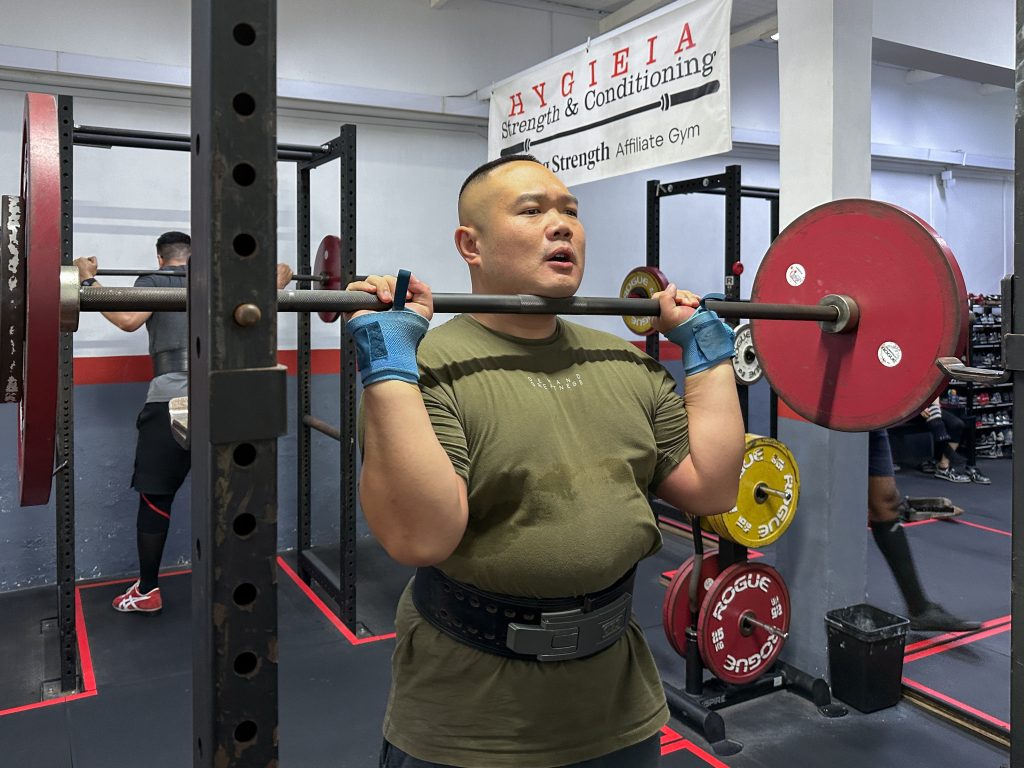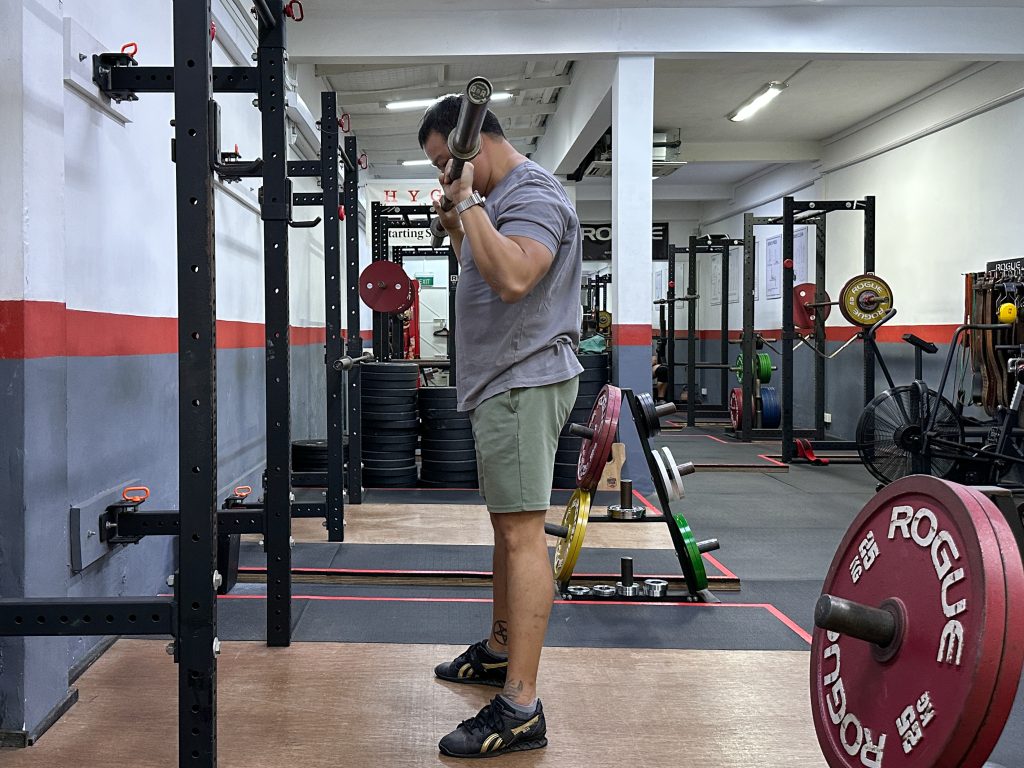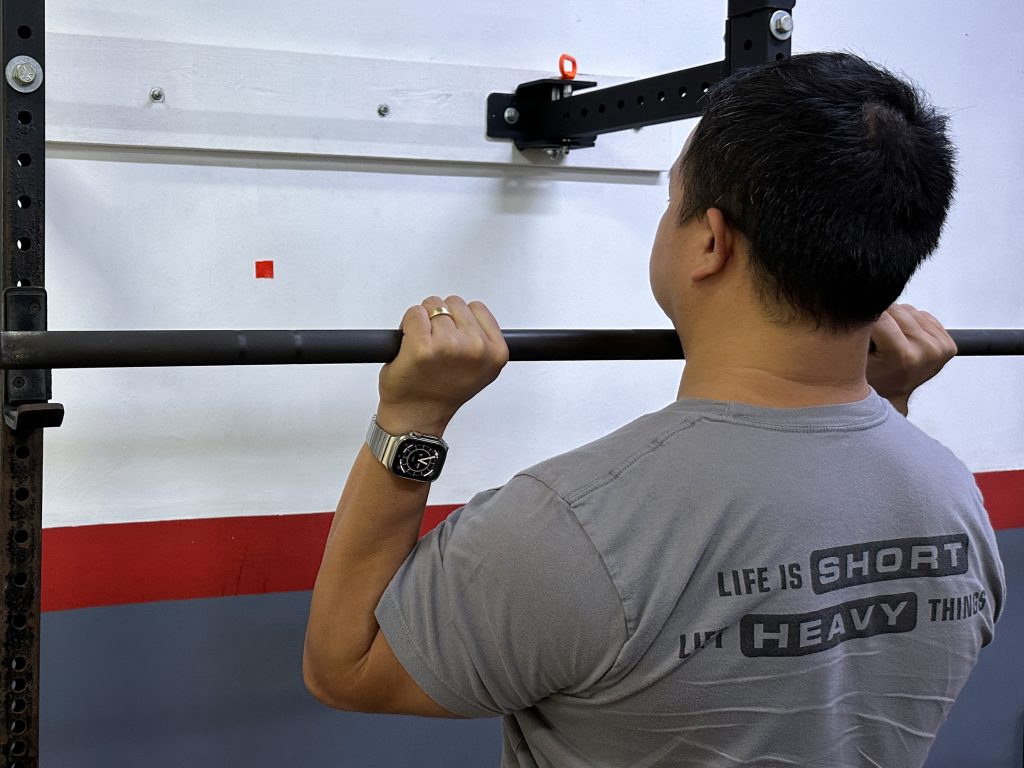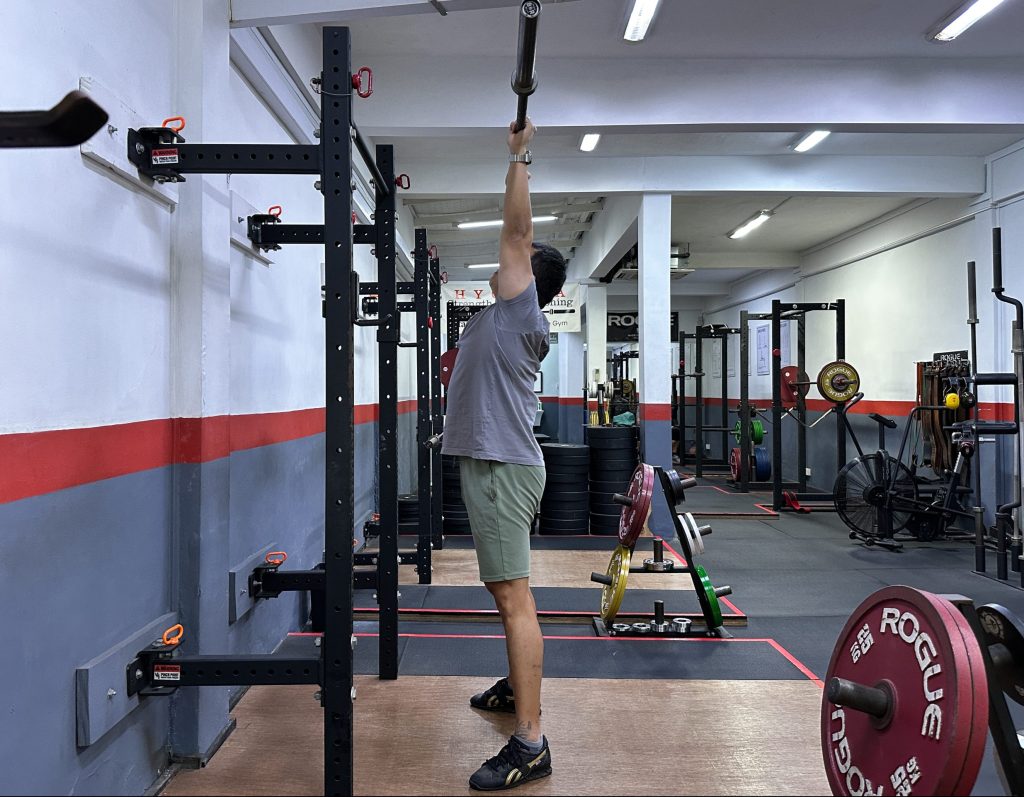
Where you fix your eyes gaze while performing the barbell lifts is important. While we all know where we should fix our eye gaze when we squat because it has been talked about ad nauseam, the eye gaze on the press doesn’t get quite that much attention.
But just because it doesn’t get that much attention doesn’t mean it’s not important. Where to look when you press is mentioned in the Blue Book for good reason.
Where you focus your eyes has a significant impact on your barbell/lifter relationship and balance, and thus lifting efficiency. Let’s break down why eye gaze matters in the press, where to look, and why.
Where should you look at?
The ideal gaze is quite straightforward for the basic barbell lifts. For the squat, it’s roughly 1.5 metres away from you on the floor; for the deadlift and power clean, around 3.5 metres away; and for the bench press, it’s straight up at the ceiling.
For the press, your gaze should be dead ahead throughout the set, at eye or forehead level. This helps you maintain balance and a steady, stable setup from the moment you unrack the bar until you rerack it.
Don’t look down before to check your stance
One common mistake new lifters make when setting up to press is looking down. If you have the habit of looking down at your feet to set your stance before you start to press, stop.
After unracking the bar, they take a couple of steps back to the starting position. So far so good. But then they glance down to look and adjust their feet position before starting to press. Making sure your stance is correct is good, right? Well, no because it leads to several issues.

Firstly, it introduces unnecessary moment arms. To see your feet, you have to bend over slightly and move your arms and the barbell out of the way. So your arms lower and your elbows shift posteriorly. When you’re done checking and adjusting your stance, you stand back up straight, but guess what? In my experience, I’ve never seen the arms come back up to the initial position before the lifter decided to check his stance. Instead, they’re left in the “lowered” position. So your elbows are “behind” the barbell instead of directly below it, which introduces an unnecessary moment arm.
To regain that vertical barbell/elbow joint relationship, the lifter will usually compensate in two ways: either allowing the wrist to extend, or by leaning back. If the barbell is light enough, the lifter can get away by producing more force to overcome the inefficiency but will find it tough to maintain that position. All three scenarios are not ideal.
Secondly, it’s unnecessary movement. For the press, foot placement isn’t that important. Set it roughly similar to your squat stance and you’re good to go. Maybe it’s the carryover process of setting your stance on the lifts you do standing (squat/deadlift/power clean), which is taught, reinforced, practised and checked, but you don’t need to check your stance in the same way for the press since it doesn’t rely on ground reaction force.
Minimise inefficiency
Okay, but what if you make sure to get back to the correct position after checking your stance? Does it matter then? Well, it’s still an unnecessary step that requires you to expend energy to prevent the bar from falling forward and then having to bring it back up to the start position. In addition to that, you’re holding the bar in your hands for an extra few seconds, which will start to accumulate a bit of fatigue. All this even before you do your first rep. Why not channel this unnecessary expenditure of energy towards pressing the bar instead?
This looking down to check your stance is mainly a new lifter problem, because a) we’d correct the problem early on and b) they can get away with it because the weights are still light.
Let’s say you train alone and this problem isn’t solved as go along on your novice linear progression. You’ll get away with it at the start when the load is light, but as the weight on the bar goes up, these inefficiencies will limit the amount of weight you’re able to press.
So instead of looking down, just guesstimate your stance. Since the press doesn’t rely on ground reaction force like the squat or deadlift, precision isn’t as critical. Your stance will be roughly around your squat stance – too narrow and it’ll be unstable, too wide and it’ll feel odd.
Where to fix your gaze
During the setup, your eyes should be dead ahead while you estimate your stance. During the set, it’s similar – your eyes should stay locked on an unmoving object, ideally one that is close by.
The best would be a fixed wall directly in front of you. If you struggle with focusing, one simple trick is to mark a specific point on the wall instead of looking at the wall in general. If we have a lifter that’s having issues with where to focus their eyes, we stick a bit of tape on the wall and tell them to fix their eyes on it. This gives them a concrete point to lock their gaze on.

But if your gym doesn’t have a wall in front of where you’re pressing, don’t worry. Focus on any stationary object in your line of sight, such as a pillar or machine. If there’s really nothing nearby, you could choose a wall in the distance as a last resort. Ideally, choose a point slightly above head height, so that your gaze remains uninterrupted even if someone walks past. What if there’s a mirror right in front of the rack where you’re pressing? You can either turn to face the other way, or fix your eyes on a spot behind you being reflected in the mirror.
What happens if you look up instead?
During the set, some lifters have a tendency to move their gaze up. Don’t do this. Because your body follows where your eyes go. Eyes look up, head lifts and you’ll lean back slightly, which will affect your overall body position.
At the lockout, the bar should be directly over your shoulder joint and mid-foot. (Check: are your shoulders covering around the outer rim of your ear?)
If you’re looking up, it almost always results in the wrong lockout position – you’ll be leaning back slightly, and the barbell will lock out slightly anterior of your shoulders. This throws off the vertical relationship needed between the barbell, shoulder joint and midfoot for a stable lockout position.

Not sure if your eye gaze is a little too high? That’s why we always recommend you to video yourself. The press is usually videoed from the front oblique angle around chest height, which lets you check if your eyes are mistakenly looking down (when setting your stance) or looking up (during the set).
More tips for the press
In our library, we have a pretty extensive range of videos and articles that discuss common technical issues, with tutorials on how to solve them. Here’s a selection that’s relevant to our topic today.
- For a quick recap on general setup, here’s a beginner’s guide on how to safely set up for all the lifts. Check out the section on the press to make sure you have the right rack height.
- Some lifters fiddle around with adjustments between unracking and the first rep, taking too long, getting fatigued and potentially missing the rep/set. This video shows talks about the zeroth rep, which is basically optimising your set up to minimise this idle time.
- Here’s another, more detailed video about getting the right elbow position. For lifting geeks, it also discusses moment forces and how they contribute to maintaining an efficient, vertical bar path in the press.
- Another common issue is the wrong grip width. Check out this article on getting the right press grip for you.
- Finally, here’s a checklist for form that gives us a framework for evaluating form deviation.
Keep your gaze focused for a stronger press
In short, keeping your gaze straight ahead during the press is crucial for efficiency and balance. It is detrimental and unnecessary to look down to check your stance, and looking up as you press messes up your balance and lockout position – simply focus on a fixed point straight ahead in front of you.
This small change can make a big difference in efficiency, especially when the weight on the bar starts to get heavy. So fix your eyes on a single spot and keep it there for the entire set.

